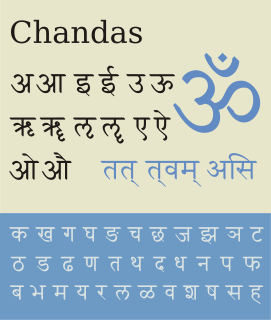
Chinese input methods are methods that allow a computer user to input Chinese characters. Most, if not all, Chinese input methods fall into one of two categories: phonetic readings or root shapes. Methods under the phonetic category usually are easier to learn but are less efficient, thus resulting in slower typing speeds because they typically require users to choose from a list of phonetically similar characters for input; whereas methods under the root shape category allow very precise and speedy input but have a difficult learning curve because they often require a thorough understanding of a character's strokes and composition.

Devanagari, also called Nagari, is a left-to-right abugida (alphasyllabary), based on the ancient Brāhmī script, used in the Indian subcontinent. It was developed in ancient India from the 1st to the 4th century CE and was in regular use by the 7th century CE. The Devanagari script, composed of 47 primary characters including 14 vowels and 33 consonants, is one of the most adopted writing systems in the world, being used for over 120 languages. The ancient Nagari script for Sanskrit had two additional consonantal characters.
"Devanāgarī" is the name of the South Asian writing system used for languages including Hindi, Marathi, Nepali and Sanskrit. There are several somewhat similar methods of transliteration from Devanāgarī to the Roman script, including the influential and lossless IAST notation.
The National Library at Kolkata romanisation is a widely used transliteration scheme in dictionaries and grammars of Indic languages. This transliteration scheme is also known as (American) Library of Congress and is nearly identical to one of the possible ISO 15919 variants. The scheme is an extension of the IAST scheme that is used for transliteration of Sanskrit.

An input method is an operating system component or program that allows any data, such as keyboard strokes or mouse movements, to be received as input. In this way users can enter characters and symbols not found on their input devices. Using an input method is obligatory for any language that has more graphemes than there are keys on the keyboard.
The International Alphabet of Sanskrit Transliteration (IAST) is a transliteration scheme that allows the lossless romanization of Indic scripts as employed by Sanskrit and related Indic languages. It is based on a scheme that emerged during the nineteenth century from suggestions by Charles Trevelyan, William Jones, Monier Monier-Williams and other scholars, and formalised by the Transliteration Committee of the Geneva Oriental Congress, in September 1894. IAST makes it possible for the reader to read the Indic text unambiguously, exactly as if it were in the original Indic script. It is this faithfulness to the original scripts that accounts for its continuing popularity amongst scholars.
ISO 15919 "Transliteration of Devanagari and related Indic scripts into Latin characters" is one of a series of international standards for romanization by the International Organization for Standardization. It was published in 2001 and uses diacritics to map the much larger set of consonants and vowels in Brahmic scripts to the Latin script.
Simplified Cangjie, known as Quick or Sucheng is a stroke based keyboard input method based on the Cangjie IME (倉頡輸入法) but simplified with select lists. Unlike full Cangjie, the user enters only the first and last keystrokes used in the Cangjie system, and then chooses the desired character from a list of candidate Chinese characters that pops up. This method is popular in Taiwan and Hong Kong, the latter in particular.
The "Indian languages TRANSliteration" (ITRANS) is an ASCII transliteration scheme for Indic scripts, particularly for Devanagari script.
The pinyin method refers to a family of input methods based on the pinyin method of romanization.
There are several romanization schemes for the Malayalam script, including ITRANS and ISO 15919.
Google Pinyin IME was an input method developed by Google China Labs. The tool was made publicly available on April 4, 2007. Aside from Pinyin input, it also includes stroke count method input. As of March 2019, Google Pinyin has been discontinued and the download page tools.google.com/pinyin/ has been deleted. However, Google Pinyin IME can still be obtained from https://dl.google.com/pinyin/v2/GooglePinyinInstaller.exe.
Indic Computing means "computing in Indic" i.e. Indian Scripts and Languages. It involves developing software in Indic Scripts/languages, Input methods, Localization of computer applications, web development, Database Management, Spell checkers, Speech to Text and Text to Speech applications and OCR in Indian languages.
Sinhala language software for computers have been present since the late 1980s but no standard character representation system was put in place which resulted in proprietary character representation systems and fonts. In the wake of this CINTEC introduced Sinhala within the UNICODE standard. ICTA concluded the work started by CINTEC for approving and standardizing Sinhala Unicode in Sri Lanka.
Google IME is a set of typing tools by Google for 22 languages, including Amharic, Arabic, Bengali, Chinese, Greek, Gujarati, Hindi, Japanese, Kannada, Malayalam, Marathi, Nepali, Persian, Punjabi, Russian, Sanskrit, Serbian, Tamil, Telugu, Tigrinya, and Urdu. It is a virtual keyboard that allows users to type in their local language text directly in any application without the hassle of copying and pasting.
Google Input Tools is a transliteration typing service for languages with non-latin Alphabets.
Indian blogosphere is the online predominantly community of Indian weblogs that is part of the larger blogosphere.
Bengali input methods refer to different systems developed to type Bengali language characters using a typewriter or a computer keyboard.

Azhagi is a freeware transliteration tool used to convert the words to regional languages like Tamil, Hindi and some other Indian languages which The Hindu named as among the transliteration tools that "stand out" in 2002. Since 2000, Azhagi has provided support to Tamil transliteration; later this was expanded to nearly 13 Indian Languages.
Tamil input methods refer to different systems developed to type Tamil language characters using a typewriter or a computer keyboard. Several programs such as Azhagi and NHM writer provide both fixed and phonetic type layouts for typing.



